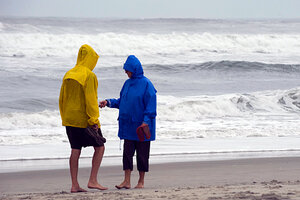Hurricane Irene winds diminish, but a sloppy Category 2 still expected
Defying expectations, hurricane Irene weakened Friday afternoon – and opportunity for rebuilding its intensity is limited. North Carolina and the inland northeast remain at high risk for flooding.

David Gagnon (l.) and Sue Gagnon walk the shoreline as waves from hurricane Irene begin to pound Atlantic Beach, North Carolina on Friday, August 26.
Steve Nesius/Reuters
Beaufort, N.C.
Against predictions, hurricane Irene lost strength Friday afternoon, now registering as a weakening Category 2 hurricane with little chance of revival before it hits North Carolina on Saturday. While Irene's wind speeds dropped to about 100 miles per hour, the risks for inland flooding remained high, with the storm expected to drop as many as 8 inches of rain on water-logged parts of the mid-Atlantic and New England.
“With its eyewall collapsed and just 24 more hours over water before landfall, it is unlikely Irene will have time to build a new eyewall and intensify,” writes meteorologist Jeff Masters on Wunderground.com. “The storm is too large to weaken quickly, and the best forecast is that Irene will be a Category 2 hurricane at landfall in North Carolina on Saturday, and a rapidly weakening Category 1 hurricane at its second landfall in New England on Sunday.”
The storm's massive 290-mile breadth, however, will mean an oversized storm surge in many coastal areas, including parts of the Northeast, Mr. Masters writes. The combination of a new moon high tide and a possible 10-foot storm surge means North Carolina faces the greatest threat of flooding. Major wind damage remains likely especially for coastal Carolina and the Outer Banks. Much of the East Coast remains at risk for flooding and power outage.
Because of the storm's unusual path and concerns about flooding, New York City Mayor Michael Bloomberg ordered first-ever evacuations for low-lying parts of the city Friday and a shutdown of the city's mass transit system starting on Saturday.
On Friday, Irene sent 22-foot offshore waves toward North Carolina's Onslow Bay. Massive rain bands pounded Beaufort, N.C., which may be the site of the landfall of the storm's remaining center core.
Large parts of the East Coast buzzed with activity, and stores in places like Beaufort quickly sold out of sundries and ice. Residents here completed preparations, including boarding up windows with plywood. Officials say such preparation is never wasted, and that people shouldn't drop their guard even if the storm loses strength. Nevertheless, many Beaufort residents say a Category 2 designation means that they'd stay and face down the storm instead of evacuating.
“We hope for the best, but we have prepared for the worst,” President Obama said about the federal government's efforts to move supplies and life-saving equipment to staging areas up and down the coast.
Hurricane forecasting has improved since hurricane Katrina struck New Orleans in August 2005, but Irene's failure to intensify as predicted hints at the challenging realities of getting it right. National Hurricane Center director Bill Read on Friday called such forecasting “both science and an art.”
“Irene is a reminder of how much mystery remains in the science of hurricane intensity forecasting,” writes weather blogger Brendan Loy, at Weather Nerd. “All of the meta conditions were ripe for her becoming a monster. But disruptions in the storm's own internal structure – the least well understood part of a hurricane – have prevented Irene from getting her act together....” At the same time, he adds, “Those fears of a Category 4 monster were not unjustified hype.”
